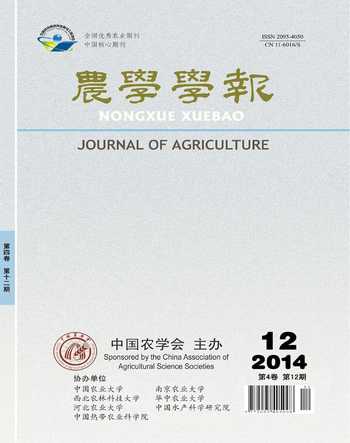盐分逆境对园艺作物品质的影响
2014-04-29崔世友张蛟蛟
崔世友 张蛟蛟
摘 要:盐胁迫是作物生产中主要的非生物逆境之一,本研究根据已有的报道,从品尝品质、次生代谢物的积累和微量元素的缺乏等3个方面对盐胁迫对园艺作物品质的影响进行了综述,以期为沿海滩涂盐碱地耐盐植物的筛选和生产提供指导。
关键词:盐分逆境;园艺作物;品质
中图分类号:S63-3 文献标志码:A 论文编号:2014-0129
Effects of Salt Stress on the Quality of Horticultural Crops
Cui Shiyou, Zhang Jiaojiao
(Jiangsu Yanjiang Institute of Agricultural Sciences/Nantong Public Technology Service Platform of Salt-tolerant Plants,
Nantong 226541, Jiangsu, China)
Abstract: Salt stress is one of the major abiotic stresses in crop production. According to the investigations published, the effects of salt stress on the quality of horticultural crops were reviewed from 3 aspects of the tasting quality, accumulation of secondary metabolites and microelements deficiency, so as to provide guidance for salt-tolerant crop screening and crop production.
Key words: Salt Stress; Horticultural Crops; Quality
0 引言
世界上盐碱土的面积很大,根据FAO在2010年发布的报告,全球盐碱地总面积为831×106 hm2[1]。在气候干燥的半干旱、干旱地区,由于降雨量低、蒸发剧烈,盐分不断积累;海滨地区由于海水倒灌造成土壤含盐量增加。中国盐碱土主要分布于西北、华北、东北和滨海地区,随着大棚面积的逐年增长和栽培年代的推移,土壤盐渍化日趋严重。
与盐分逆境对作物产量的影响相比,人们对盐分逆境对作物经济产品品质的影响所知甚少。在已有的研究中,园艺作物方面的研究较多,大田作物研究较少。因此,本研究对园艺作物在盐胁迫下的品质表现进行综述,以期为沿海滩涂盐碱地耐盐作物的筛选和生产提供指导。
1 盐胁迫对园艺作物品尝品质的影响
在1块用盐水种植达10年的试验田,设计3个盐水灌溉处理:43、86和171 mmol/L,对照为非盐水灌溉,研究盐水灌溉对加工番茄产量、品质的影响[2]。盐分抑制了叶面积和根密度,这可能与植物对盐逆境的功能性适应有关。86 mmol/L中度盐分的处理也未对产量成熟显著影响,只是盐水灌溉的果品较小;但是,盐胁迫下的番茄具有较高的酸度、可溶性固形物增加、糖含量较高。中度盐分下产量的减少可通过番茄品质的强化而得以补偿。盐分下总可溶性固形物的浓度增加与减少水分含量、离子积累和有机分子的从头合成有关,在高渗透环境下,有机酸具有多个功能,包括渗透调节和活性氧的区隔。
盐分环境下酸度和糖分的增加已在多种蔬菜中有报道,如茄子[3]、番茄[4-6]、甜瓜[7]、黄瓜[8]和西瓜[9],盐逆境下有机酸的积累增加;而黄瓜、番茄、甜瓜和西瓜[5,9-12]在鹽胁迫下增加了还原性糖的积累。另外,黄瓜、番茄、甜瓜和西瓜[6,9-13]、果品的总可溶性固形物随盐分而增加;而在辣椒中未观察到类似的现象[14],可能是果品的呼吸随着营养液中离子强度的增加而增加[15]。
盐胁迫对草莓食用品质表现出了明显的差异。利用对盐分逆境存在差异的2个草莓品种Elsanta(敏感)和Korona(耐),在0、40、80 mmol/L的NaCl下生长2个月(开花至最后果品收获),以此鉴定盐胁迫对草莓品种的影响[16]。一般而言,盐分降低草莓品质尤其是Elsanta品种,受胁迫植株草莓的糖、有机酸和可溶性固形物含量较低,甜度较低不适合消费者需求;果品的整体外观明显下降。而在另一个长期胁迫长达4个月的试验中[17],结果却有些变化,平均果重下降,而干物质、总可溶性碳水化合物含量以及甜度指数保持不变。
2 盐胁迫有利于植物次生代谢物的积累
水果、蔬菜的抗氧化活性对评估其营养价值是重要的。植物在应答盐分和其他环境逆境时,一些对抗击重要疾病如癌症、心血管疾病的许多高营养价值的次生代谢物在鲜果菜中积累[18]。
轻度的盐胁迫可改进亲脂和亲水抗氧化活性。中度盐分下番茄果中类胡萝卜素浓度提高40%[18],其原因主要是增强了番茄红素的含量,其生物合成在逆境下被激活[19];而当根际盐分高于4 dS/m时,总类胡萝卜素和番茄红素的含量逐渐下降[20]。Petersen等[20]、Stamatakis等[21]也有类似的报道。但是,抗氧化代谢途径的应答在很大程度上依赖于胁迫的水平以及其他栽培/环境因子。而叶黄素应答盐分与此不同,其含量随盐分而表现出增加的趋势[21]。
盐分(0、15、30 mmol/L)和不同成熟阶段(绿果期、转色期、红果期)对辣椒的几种抗氧化剂成分影响的温室试验研究表明[22],从营养角度看红果期是最理想的成熟状态,此时番茄红素、β-胡萝卜素和糖含量最高,亲脂性和亲水性抗氧化剂活性最高。盐分的影响与成熟状态有关:对水溶性抗氧化剂(HAA)、β-胡萝卜素和糖无影响,但降低抗坏血酸和总酚类化合物,增加了脂溶性抗氧化剂(LAA)和番茄红素。
另一種高值代谢物抗坏血酸在应答水分逆境和盐分时分别增加[18,20-21]或减少[23]。Vc增加归因于植物适应盐分过程中果品水分含量的减少[20]。由于抗坏血酸包含于几种代谢途径中,其合成也与其他因子如N利用存在互作[19]。
耐性不同的2个草莓品种Elsanta(敏感)和Korona(耐)在4个月的长期盐胁迫(2个营养季用含0、40、 80 mmol/L的NaCl营养液处理)下品质的应答研究[24]表明,中度盐分增加了抗氧化能力,Korona在盐逆境下超氧化物歧化酶活性和谷胱甘肽、酚类、花青素含量增加,而抗坏血酸含量下降。品种Elsanta超氧化物歧化酶活性及抗坏血酸含量的变化与品种Korona类似,而抗坏血酸下降更明显。花色苷的含量下降,酚类似。谷胱甘肽含量在最高NaCl时下降。这些结果表明盐敏感低的草莓品种可在中度盐逆境下种植,以优化果品品质。
GSLs(芥子油甙)是在主要十字花科蔬菜中植物如花椰菜和甘蓝中发现的次生化合物,盐逆境对S吸收和积累存在影响,花椰菜花球在应答盐逆境中S增加,而在叶片中没有变化;西兰花中也观察到中度的增加[25-26]。S是硫代葡萄糖苷和异硫氰酸酯的重要前体,后者表现出抗癌活性体现芸薹属植物的营养价值[27]。小白菜在中度盐分下,总GSLs也表现为增加[28]。在盐逆境下GSLs增加,表明在低水势下GSLs参与了渗透调节,可能是耐盐性的适应性组分[29]。进一步的研究表明,盐逆境对不同西兰花品种的影响不同,品种Parthenon的总GSLs含量不受盐逆境的影响,而品种Naxos则显著下降,原因在于吲哚GSLs的下降。盐逆境下Naxos比Parthenon积累过多的aliphatic GSLs,从而使得改品种在盐逆境下种植更具营养价值[30]。
3 盐分胁迫易引起植株体内微量元素的缺乏
盐分的一种副作用是微量元素的缺乏,由土壤碱化和离子竞争所引起[31]。盐逆境引起的微量元素缺乏还产生不正常的植株生长和不规则的果品发育。番茄在盐逆境下产生K、Cu和Zn的缺乏[2]。
逆境诱导的离子积累和分配可解释不同物种间的特定应答,花椰菜比西兰花在应答盐逆境中积累更多的Ca2+,这可保护花椰菜免遭干烧心病以及成熟前的叶片衰老;而西兰花该病的发生则相对较多。同样,Ca2+缺乏也导致生菜、菊苣和茴香的品质变劣[32]。施Zn改进了盐胁迫下的生长[33],在碱土下比在盐土、盐碱土下效果更大[34-35]。
4 结论与讨论
盐逆境是主要的非生物逆境之一,对园艺作物产品品质有重要影响。盐胁迫下鲜果蔬的可溶性固形物增加,酸度、糖含量较高。在中度盐胁迫下,类胡萝卜素、番茄红素、花青素、芥子油甙(GSLs)等高营养价值的次生代谢物在鲜果菜中积累增加,但盐胁迫易引起植株体内一些微量元素的缺乏。在沿海滩涂盐碱地开发果蔬种植时,应充分利用盐逆境对提高鲜食果蔬品质有利的一面,如加强了一些次生代谢物的积累。对于不利的一面,如引起Ca2+、K+和Zn2+等的缺乏,在果蔬生产中应采取措施,增施相应的肥料,减缓盐逆境对果蔬生产发育的影响。盐逆境与土壤矿质营养的互作,及其对果蔬生长发育的影响是一个值得探讨的研究方向,对滨海盐土果蔬生产也有参考借鉴作用。
参考文献
[1] Martinez-Beltran J, Manzur C L. Overview of salinity problems in the world and FAO strategies to address the problem[C].California: Proceedings of the international salinity forum, Riverside,2005:311-313.
[2] Maggio A, De Pascale S, Angelino G, et al. Physiological response of tomato to saline irrigation in long-term salinized soils[J].Eur. J. Agron.,2004,21:149-159.
[3] Savvas D, Lenz F. Influence of NaCl concentration in the nutrient solution on mineral composition of eggplants grown in sand culture[J].Angewandte Botanik,1996,70:124-127.
[4] Kafkafi U, Valoras N, Letey J. Chloride interaction with nitrate and phosphate nutrition in tomato (Lycopersicon esculentum L.)[J].J. Plant Nutr.,1982,5:1369-85.
[5] De Pascale S, Martino A, Raimondi G, et al. Comparative analysis of water and salt stress-induced modifications of quality parameters in cherry tomato [J].J. Hort. Sci. Biotec.,2007,82:283-289.
[6] Mitchell J P, Shennan C, Grattan S R, et al. Tomato fruit yields and quality under water deficit and salinity [J].J. Am. Soc. Hort. Sci.,1991,116:215-221.
[7] Feigin A, Rylski I, Meiri A, et al. Response of melon and tomato plants to chloride-nitrate ratios in saline nutrient solutions[J].J. Plant Nutr.,1987,10:1787-1794.
[8] Martinez V, Cerdá A. Influence of N source on rate of Cl, N, Na, K uptake by cucumber seedlings grown in saline conditions[J].J. Plant Nutr.,1989,12:971-983.
[9] Colla G, Roupahel Y, Cardarelli M, et al. Effect of salinity on yield, fruit quality, leaf gas exchange, and mineral composition of grafted watermelon plants[J].HortScience,2006,41(3):622-627.
[10] Adams P, Ho L C. Effects of constant and fluctuating salinity on the yield, quality and calcium status of tomatoes[J].J. Hortic. Sci.,1989,67:725-732.
[11] Navarro J M, Botella M A, Cerdá A, et al. Yield and fruit quality of melon plants grown under saline conditions in relation to phosphate and calcium nutrition[J].J Hortic Sci Biotech,1999,74:573-578.
[12] Schaffer A A, Rylski I, Fogelman M. Carbohydrate content and sucrose metabolism in developing Solanum muricatum[J].Phytochemistry,1989,28:737-739.
[13] Mendlinger S, Fossen M. Flowering, vegetative growth, yield, and fruit quality in muskmelons under saline conditions[J].Journal of the American Society for Horticultural Science,1993,118(6):868-872.
[14] Navarro J M, Garrido C, Flores P, et al. The effect of salinity on yield and fruit quality of pepper grown in perlite[J].Spanish Journal of Agricultural Research,2010,8(1):142-150.
]15] Tadesse T, Nichols M A, Fisher K J. Nutrient conductivity effects on sweet pepper plants grown using a nutrient film technique 1. Yield and fruit quality[J].New Zeal J Crop Hort,1999,27:229-237.
[16] Keutgen A, Pawelzik E. Modifications of taste-relevant compounds in strawberry fruit under NaCl salinity[J].Food chemistry,2007,105(4):1487-1494.
[17] Keutgen A J, Pawelzik E. Quality and nutritional value of strawberry fruit under long term salt stress[J].Food Chemistry,2008,107(4):1413-1420.
[18] De Pascale S, Maggio A, Fogliano V, et al. Irrigation with saline water improves carotenoids content and antioxidant activity of tomato[J].J. Hort. Sci. Biotec.,2001,76:447-453.
[19] Giuliano G, Bartley G E, Scolnik P A. Regulation of carotenoid biosynthesis during tomato development[J].Plant Cell,1993,5:379-387.
[20] Petersen K K, Willumsen J, Kaack K. Composition and taste of tomatoes as affected by increased salinity and different salinity sources[J].J. Hort. Sci.,1998,73:205-215.
[21] Stamatakis A, Papadantonakis N, Savvas D, et al. Effects of silicon and salinity on fruit yield and quality of tomato grown hydroponically[C].International Symposium on Managing Greenhouse Crops in Saline Environment,2003:141-147.
[22] Navarro J M, Flores P, Garrido C, et al. Changes in the contents of antioxidant compounds in pepper fruits at different ripening stages, as affected by salinity[J].Food Chemistry,2006,96(1):66-73.
[23] Dumas Y, Dadomo M, Di Lucca G, et al. Effects of environmental factors and agricultural techniques on antioxidant content of tomatoes[J].J. Sci. Food Agric.,2003,83:369-382.
[24] Keutgen A J, Pawelzik E. Modifications of strawberry fruit antioxidant pools and fruit quality under NaCl stress[J].Journal of agricultural and food chemistry,2007,55(10):4066-4072.
[25] De Pascale S, Maggio A, Barbieri G. Soil salinization affects growth, yield and mineral composition of cauliflower and broccoli[J].Eur. J. Agron.,2005,23:254-264.
[26] C. López-Berenguer, M. C. Martínez-Ballesta, C. García-Viguera, et al. Leaf water balance mediated by aquaporins under salt stress and associated glucosinolate synthesis in broccoli[J].Plant Science,2008,174(3):321-328.
[27] Barbieri G, Pernice R, Maggio A, et al. Glucosinolates profile of Brassica rapa L. subsp Sylvestris L. Janch. var. esculenta. Hort[J].Food Chem.,2008,107:1687-1691.
[28] Hu K L, Zhu Z J. Effects of different concentrations of sodium chloride on plant growth and glucosinolate content and composition in pakchoi[J].African Journal of Biotechnology,2010,9(28):4428-4433.
[29] López-Berenguer C, Martínez-Ballesta M D C, Moreno D A, et al. Growing hardier crops for better health: salinity tolerance and the nutritional value of broccoli[J].Journal of Agricultural and Food Chemistry,2009,57(2):572-578.
[30] Zaghdoud C, Alcaraz-López C, Mota-Cadenas C, et al. Differential responses of two broccoli (Brassica oleracea L. var Italica) cultivars to salinity and nutritional quality improvement[J].The Scientific World Journal,2012,doi:10.1100/2012/291435.
[31] Grattan S R, Grieve C M. Salinity-mineral nutrient relations in horticultural crops[J].Sci. Hort.,1999,78:127-157.
[32] De Pascale S, Barbieri G. Effects of soil salinity from long-term irrigation with saline-sodic water on yield and quality of winter vegetable crops[J].Sci. Hort.,1995,64:145-157.
[33] El-Sherif A F, Shata S M, Youssef R A. Response of tomato seedlings to zinc application under different salinity levels I. Dry matter, Ca, Mg, K and Na content[J].Egypt. J. Hort.,1990,17:131-142.
[34] Mehrotra N K, Khanna V K, Agarwala S C. Soil-sodicity-induced zinc deficiency in maize[J].Plant Soil,1986,92:63-71.
[35] Shukla U C, Mukhi A K. Ameliorative role of zinc on maize growth (Zea mays L.) under salt-affected soil conditions[J].Plant Soil,1985,87:423-432.
